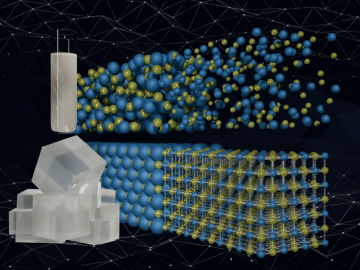
Filter News
Area of Research
- Advanced Manufacturing (1)
- Biology and Environment (17)
- Computational Biology (1)
- Computational Engineering (1)
- Computer Science (3)
- Electricity and Smart Grid (1)
- Energy Science (80)
- Energy Sciences (1)
- Functional Materials for Energy (2)
- Fusion and Fission (10)
- Fusion Energy (8)
- Isotopes (1)
- Materials (41)
- Materials for Computing (5)
- National Security (5)
- Neutron Science (13)
- Nuclear Science and Technology (14)
- Nuclear Systems Modeling, Simulation and Validation (1)
- Supercomputing (51)
News Topics
- (-) Advanced Reactors (40)
- (-) Energy Storage (114)
- (-) Molten Salt (10)
- (-) Summit (71)
- 3-D Printing/Advanced Manufacturing (147)
- Artificial Intelligence (131)
- Big Data (79)
- Bioenergy (112)
- Biology (128)
- Biomedical (73)
- Biotechnology (39)
- Buildings (74)
- Chemical Sciences (86)
- Clean Water (33)
- Composites (35)
- Computer Science (226)
- Coronavirus (48)
- Critical Materials (29)
- Cybersecurity (35)
- Education (5)
- Element Discovery (1)
- Emergency (4)
- Environment (218)
- Exascale Computing (67)
- Fossil Energy (8)
- Frontier (64)
- Fusion (67)
- Grid (74)
- High-Performance Computing (130)
- Hydropower (12)
- Irradiation (3)
- Isotopes (62)
- ITER (9)
- Machine Learning (68)
- Materials (157)
- Materials Science (158)
- Mathematics (12)
- Mercury (12)
- Microelectronics (4)
- Microscopy (56)
- Nanotechnology (64)
- National Security (86)
- Neutron Science (171)
- Nuclear Energy (122)
- Partnerships (68)
- Physics (69)
- Polymers (35)
- Quantum Computing (53)
- Quantum Science (93)
- Security (31)
- Simulation (65)
- Software (1)
- Space Exploration (26)
- Statistics (4)
- Transportation (103)
Media Contacts

Scientists have developed a new machine learning approach that accurately predicted critical and difficult-to-compute properties of molten salts, materials with diverse nuclear energy applications.
Scientists at ORNL have developed a method that can track chemical changes in molten salt in real time — helping to pave the way for the deployment of molten salt reactors for energy production.

Researchers at Georgia State University used the Summit supercomputer to study an elaborate molecular pathway called nucleotide excision repair. Decoding NER’s sophisticated sequence of events and the role of PInC in the pathway could provide key insights into developing novel treatments and preventing conditions that lead to premature aging and certain types of cancer.

During his first visit to Oak Ridge National Laboratory, Energy Secretary Chris Wright compared the urgency of the Lab’s World War II beginnings to today’s global race to lead in artificial intelligence, calling for a “Manhattan Project 2.”

P&G is using simulations on the ORNL Summit supercomputer to study how surfactants in cleaners cause eye irritation. By modeling the corneal epithelium, P&G aims to develop safer, concentrated cleaning products that meet performance and safety standards while supporting sustainability goals.

Scientists designing the world’s first controlled nuclear fusion power plant, ITER, needed to solve the problem of runaway electrons, negatively charged particles in the soup of matter in the plasma within the tokamak, the magnetic bottle intended to contain the massive energy produced. Simulations performed on Summit, the 200-petaflop supercomputer at ORNL, could offer the first step toward a solution.

ORNL’s annual workshop has become the premier forum for molten salt reactor, or MSR, collaboration and innovation, convening industry, academia and government experts to further advance MSR research and development. This year’s event attracted a record-breaking 365 participants from across the country, highlighting the momentum to bring MSRs online.

National lab collaboration enables faster, safer inspection of nuclear reactor components, materials
A research partnership between two Department of Energy national laboratories has accelerated inspection of additively manufactured nuclear components, and the effort is now expanding to inspect nuclear fuels.

Researchers at Stanford University, the European Center for Medium-Range Weather Forecasts, or ECMWF, and ORNL used the lab’s Summit supercomputer to better understand atmospheric gravity waves, which influence significant weather patterns that are difficult to forecast.

Scientists conducted a groundbreaking study on the genetic data of over half a million U.S. veterans, using tools from the Oak Ridge National Laboratory to analyze 2,068 traits from the Million Veteran Program.


